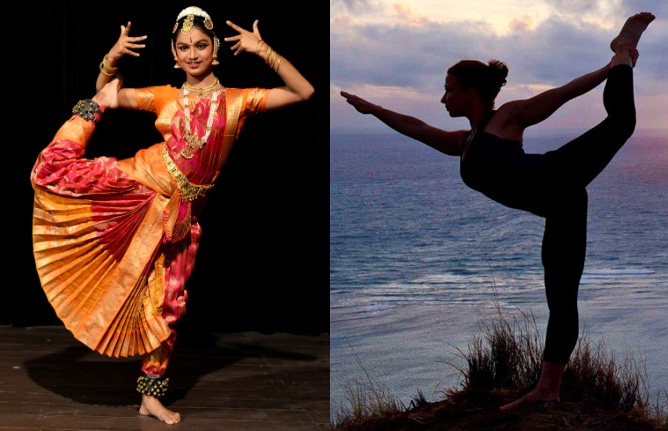Author – Tanmayee Patil

Every weekend I find my whole family (like the rest of India!) glued to television set watching the ‘not so real’ reality shows. More than anything, various western and international dance styles like b-boying, popping, hip-hop, salsa, etc are trending in through these shows. Somewhere in all this the pure Indian Classical Dances are being undermined. I accept that curiosity is a human nature and as such we all are curious to learn something new.
Like any other Indian, the announcement of the International Yoga Day on 21st June piqued my interest. So, I researched books on Yoga and came across the ‘Hand Yoga’ aka ‘Yoga Mudras’. And it dawned on me that I have practiced Hand Yoga throughout my childhood. It was a trip down memory lane when I had professionally learned Bharatnatyam. It amazed me to find that the ‘Hastas’/ ‘Mudras’ used in Bharatnatyam are very similar to the ‘Yoga Mudras’’.
Yoga states that the fingers of our hand represent the ‘Pancha Mahabhutas’ or the 5 elements. Touching one finger with others in different combinations creates circuits in our body through which energy flows. Such a flow of energy allows the body to gain better circulation of blood, indirectly formulating long-term health benefits. Different ‘Hastas’ are used to also communicate specific ideas, events, actions, or creatures. The basic Mudras which are common to all Indian Classical Dances were originally used by the Devdasis who performed in temples for entertainment of the Gods and Goddesses.
The book “Mudras: Yoga in Your Hands” by Gertrud Hirschi explicates the relation between hand positions and health. It reveals that the hands bring into use certain regions of the brain and thus, have an effect on them. In Hath Yoga, the thumb is considered symbolic of cosmos while the index finger stands for the individual consciousness. Yoga is directed towards bringing together and uniting individual to the cosmic consciousness. The adjacent mudra stands for this union.
While the birth of mudras is shrouded in mystery, the role of mudras in religious activities of India is recorded prominently with the use of hand poses to represent qualities of deities. In the words of Ingrid Ramm-Bonwitt, “With his or her hands, the Indian dancer expresses the life of the universe”. This gives testimony to the integral role of hath mudras in Indian dance forms. Here is a stream of hand yoga mudras representing the relation between hand movement and bodily health:
Hamsasya hasta
The ‘Hamsasya hasta’ in Classical Dance represents the shape of a ‘Swan’ and is also similar to ‘Gyan mudra’ in Yoga which increases the memory power, enhances concentration and prevents insomnia.


Trishula Hasta
The ‘Trishula Hasta’ depicting ‘Trishula/ Trident’ matches with ‘Varun Mudra’ which is claimed to balance the water content in body and prevent pain due to inflammation or shrinkage of muscles.
Mayura Hasta
The ‘Mayura Hasta’ symbolizing ‘Peacock’ resembles ‘Prithvi Mudra’ that improves the complexion of skin and helps to increase weight.
Simhamukha Hasta
The ‘Simhamukha Hasta’ typifying a ‘lion head’ is similar to the ‘Apana Mudra’ which regulates diabetes and helps to cure constipation and piles.
Kartarimukha Hasta
The ‘Kartarimukha Hasta’ represents ‘Scissors’ and tallys with the ‘Prana Mudra’. It removes vitamin deficiency and fatigue, improves immunity and power of eyes and reduces eye related diseases.
‘Mudras’ or ‘healthy hastas’ are a small aspect of the Indian classical dances. Other than that these dances improve our body posture, increase our flexibility, improve our body balance, give us a grace and importantly teach us discipline. Moreover, it gives you seven different options to choose from – viz. Bharatnatyam, Kuchipudi, Odissi, Kathak, Kathakali, Mohiniattam and Manipuri. So friends, go different and follow our age old culture as a cool ‘Alternative Yoga’!
Factfile –
Aarti Prakashan’s ‘Nisargopchar aani Yoga Shashtra’ by Dr. Kumud Bedarkar
Mudras: Yogas in Your Hands by Gertrud Hirschi
www.yogabasics.com














Dear Tanmayee Patil,
Kindly send me the details of above published article, ie- Date of Publication and Journal’s Name.
Dr. Vidhi Nagar
Associate Professor
Department of Dance,
Faculty of Performing Arts,
Banaras Hindu University.